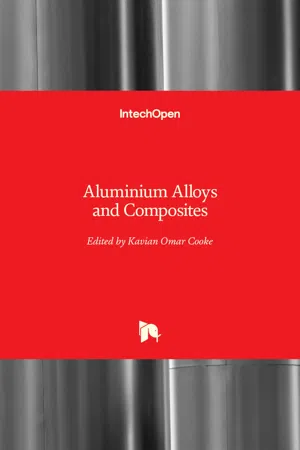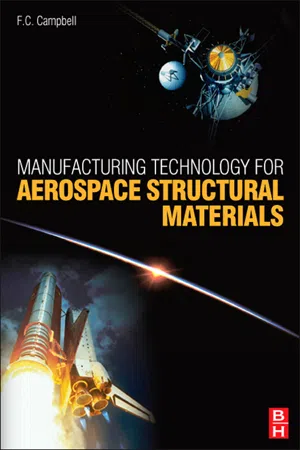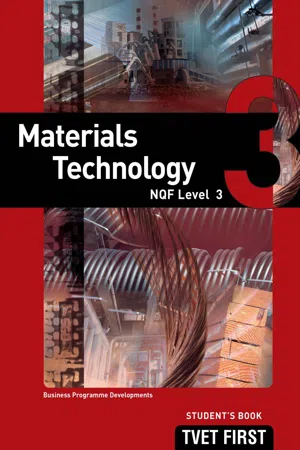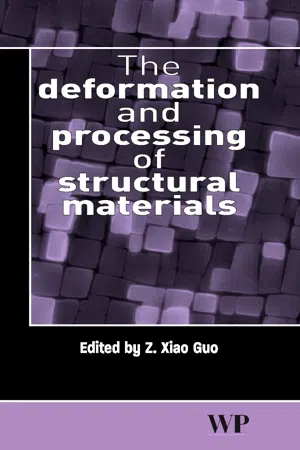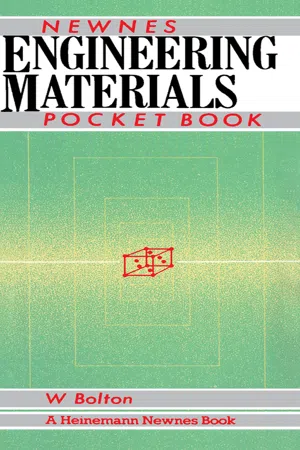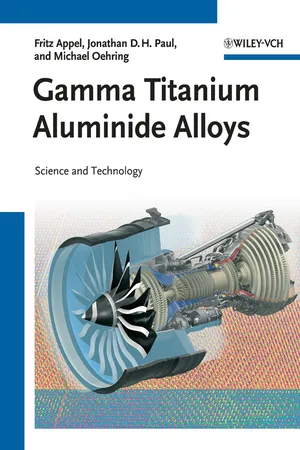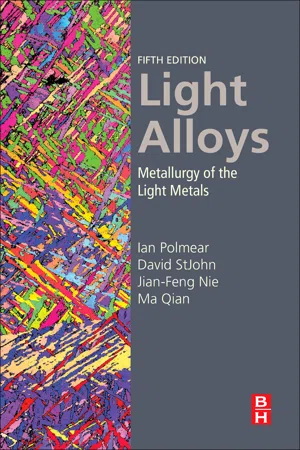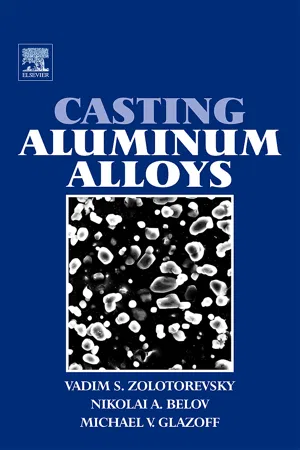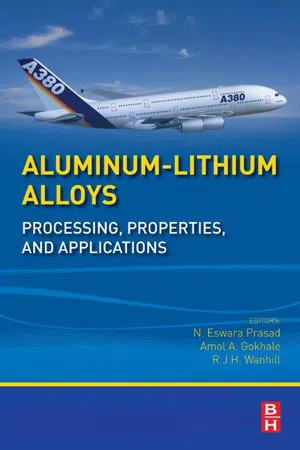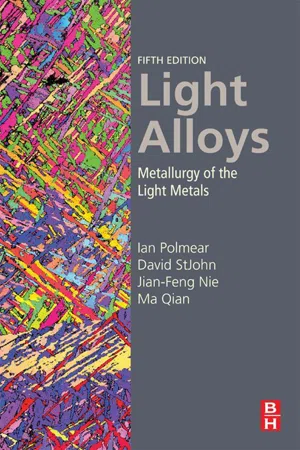Technology & Engineering
Aluminum Alloy
Aluminum alloy is a material made by mixing aluminum with other elements to enhance its properties. It is known for being lightweight, corrosion-resistant, and having good strength-to-weight ratio, making it widely used in various engineering applications such as aerospace, automotive, and construction. The alloy's versatility and durability make it a popular choice for manufacturing a wide range of products.
Written by Perlego with AI-assistance
Related key terms
1 of 5
12 Key excerpts on "Aluminum Alloy"
- eBook - PDF
- Kavian Omar Cooke(Author)
- 2020(Publication Date)
- IntechOpen(Publisher)
With the advent of alloying technology, the use of aluminium was developed farther and positioned aluminium as the most utilised industrial metal for decades. The popularity of aluminium grew due to its good attributes related to its unique properties, mainly of light-weight combined with good thermal/electrical conduction and reasonably good strength and resistance to corrosion. With alloying, aluminium has found more applications than previously envisioned, making aluminium a serious competitor with (and sometimes a pre-ferred alternative to) the traditional “strong” metals iron and steel [3]. Aluminium alloys and composites have, in most applications, exhibited superior performance compared to their rival metals. The choice of aluminium alloys and composites derives from one important attribute of aluminium metal—light-weight. Light-weight translates into many important outcomes in engineering applications. In the automotive industry, it means less dead weight, lower fuel consumption, lower emissions, increased payload (for passengers and cargo) and easier handling. In the aerospace and aircraft industry, it translates into more payload (cargo), less fuel and lower emissions. There are similar advantages in all areas where aluminium is utilised—marine, rail, packaging, thermal management, building and construction, sports and recreation, etc. Aluminium’s good electri-cal and thermal conductivity have seen its increased use in electrical conductors, electronic packaging and thermal management. Nowadays, aluminium is viewed as an important material for energy conservation and environmental protection [4]. Modern technology aims at meeting the market whose standards are ever appreciat-ing. The market demands faster, more comfortable and hassle-free transport, more compact and lighter machines and tools, more efficient methods of power generation, etc. - Flake C Campbell Jr(Author)
- 2011(Publication Date)
- Elsevier Science(Publisher)
Chapter 2 Aluminum Manufacturing Technology for Aerospace Structural Materials A typical material distribution for a modern commercial airliner, shown in Fig. 2.1, illustrates the heavy dominance of Aluminum Alloys. The attractiveness of alu-minum is that it is a relatively low cost, light weight metal that can be heat treated to fairly high strength levels, and it is one of the more easily fabricated of the high performance materials, which usually results in lower costs. The advantages of aluminum as a high performance material can be summarized: • High strength-to-weight ratio. The high strength 2XXX and 7XXX alloys are competitive on a strength-to-weight ratio with the higher strength but heavier titanium and steel alloys, and thus have traditionally been the predominate structural material in both commercial and military aircraft. • Cryogenic properties. Aluminum Alloys are not embrittled at low temper-atures and become even stronger as the temperature is decreased without significant ductility losses, making them ideal for cryogenic fuel tanks for rockets and launch vehicles. • Fabricability. Aluminum Alloys are among the easiest of all metals to form and machine. The high strength 2XXX and 7XXX alloys can be formed in a relatively soft state and then heat treated to much higher strength levels after forming operations are completed. Aluminum is also a consumer metal of great importance. In addition to the advantages cited above, other properties of commercial importance include corrosion resistance to natural atmospheres, suitability for food and bever-age storage, high electrical and thermal conductivity, high reflectivity, and ease of recycling. As a result of a naturally occurring tenacious surface oxide Other 1% Steel 11% Titanium 7% Composite 11% Aluminum 70% Fig. 2.1. Material Distribution for Boeing 777 Aircraft 1 16- eBook - PDF
Materials Technology NQF3 SB
TVET FIRST
- Business Programme Development (PTY) Ltd(Author)
- 2013(Publication Date)
- Macmillan(Publisher)
Pure aluminium contains more than 99% aluminium. These grades of aluminium are characterised by: • excellent corrosion resistance • high thermal and electrical conductivity • low strength • excellent workability. These grades of aluminium alloys contain copper as the main alloying element although other elements such as magnesium may also be included. Aluminium-copper alloys need solution heat treatment to obtain the best properties. In the solution heat-treated condition, their physical properties are similar to those of low-carbon steel. These alloys are sometimes processed with precipitation heat treatment to further increase physical properties. Although this treatment increases their strength, its effect on tensile strength is not as good. These alloys do not have as good corrosion resistance as most other aluminium alloys. Therefore, these alloys in the form of sheet are usually clad with a high purity alloy or a magnesium-silicon alloy of the 6xxx series which provides galvanic protection and thus greatly increases resistance to corrosion. Alloy 2024 is perhaps the best known and most widely used aircraft alloy. Aluminium-copper alloys are generally used for parts requiring good strength at temperatures up to 150 C. Most of these alloys have limited weldability , but some alloys have better machinability. These alloys generally are non-heat treatable but have about 20% more strength than pure aluminium. Manganese is used as the main alloying element in only a few alloys because only a limited percentage of manganese of about 1,5% can effectively be added to aluminium. Silicon can be added in sufficient quantities of up to 12% to cause a substantial lowering of the melting point without producing brittleness. Aluminium-silicon alloys are used in welding wire and as brazing alloys for joining aluminium where a lower melting point than that of the base metal is required. - eBook - PDF
Aluminium Alloys
Recent Trends in Processing, Characterization, Mechanical behavior and Applications
- Subbarayan Sivasankaran(Author)
- 2017(Publication Date)
- IntechOpen(Publisher)
Chapter 13 Effect of Alloying Element on the Integrity and Functionality of Aluminium-Based Alloy Ojo Sunday Isaac Fayomi, Abimbola Patricia Idowu Popoola and Nduka Ekene Udoye Additional information is available at the end of the chapter http://dx.doi.org/10.5772/intechopen.71399 Abstract Aluminum Alloy are gaining huge industrial significance because of their outstanding combination of mechanical, physical and tribological properties over the base metal. Alloying elements are selected based on their individual properties as they impact on the structure and performance characteristics. The choice of this modifier affects the materials integrity in service resulting to improved corrosion, tribological and mechan-ical behavior. Hence, the need to understand typically the exact inoculants that could relatively impact on the low strength, unstable mechanical properties is envisage with the help of liquid stir casting technique. In this contribution, sufficient knowledge on Al alloy produced by stir casting will be reviewed with close attention on how the struc-tural properties impact on the mechanical performance. Keywords: Aluminum Alloy, alloying element, liquid stir casting technique, reinforcement 1. Introduction The chemical composition consisting of an Aluminum Alloy is added to pure aluminum in order to improve its properties for the primary purpose of increasing the strength. The other elements such as iron, magnesium, manganese, zinc and silicon is added to build up 15% alloy by weight. If the aluminum is in molten form, the other elements is mixed with aluminum to produce the required alloy. [1]. Pure aluminum is not usually used for structural applications and that in order to produce aluminum that is of adequate strength for the manufacture of structural components, it is necessary to add other elements to the aluminum [1, 2]. The strength characteristic of aluminum (1xxx series) makes it a useful product for structural © 2017 The Author(s). - eBook - PDF
- Bernard Moody(Author)
- 2013(Publication Date)
- Arnold(Publisher)
11 Industrial alloys The need for alloys Most pure metals are not used as such in engineer-ing because of poor mechanical properties. However, the properties of a metal may be modified by the addition of other elements, usually metals but sometimes metalloids or non-metals, and the resulting product, if it has metallic physical properties, is called an alloy. The physico-chemical equilibria of alloys and their crystal structures will not be discussed in more than outline but it may be noted that compounds may be formed: cementite, Fe3C, in steel is a simple example. Alloys are generally prepared molten but this is not always possible. For very high-melting-point metals, of which molybdenum (m.p. 2895°C) and tungsten (m.p. 3400°C) are examples, the tech-nique of powder metallurgy is employed: fine powder is compressed into suitable shapes using pressures of about 750 N mm -2 followed by heating. Also, by the careful regulation of current density, electrolyte composition and temperature, direct electrodeposition of certain alloys may be accomplished. Brass may be deposited electro-lytically under suitable conditions. In describing the characteristics of metals, including alloys, for the purposes of this chapter, certain terms need to be defined. The general behaviour of a metal, described as its mechanical properties, depends on its strength, malleability, ductility, hardness, toughness and resistance, or otherwise, to corrosion. Strength refers to resist-ance to applied stresses and tensile strength to the load-supporting characteristics. Hardness des-cribes resistance to cutting, abrasion and indenta-tion, while toughness is the impact strength or resistance to fracture by impact. Rolling-out into sheets, which involves deformation by compres-sion, demands high malleability whereas wire-drawing, deformation by tensile stress, requires high ductility. - Z. X. Guo(Author)
- 2005(Publication Date)
- Woodhead Publishing(Publisher)
1 1.1 Introduction Aluminium and its alloys form an important class of structural materials. The most important characteristic of aluminum is its relatively low density compared to steels. By utilizing suitable alloying and proper heat treatment practice, specific strengths equivalent to those of high strength steels can be developed in Aluminum Alloys. In addition, aluminium alloys can be easily fabricated into useful engineering components through a variety of manufacturing processes. This has led to widespread use of aluminium alloys in automobile, aerospace, packaging and construction industries. This chapter will discuss the important aspects of deformation and processing of aluminium alloys. The introductory section (section 1.1) contains a review of the classification of aluminium alloys, heat treatable and non-heat treatable alloys, wrought aluminium alloys, cast aluminium alloys, etc. Deformation behaviour of aluminium is covered in section 1.2. Section 1.3 covers the microstructural aspects of deformation of aluminium alloys during hot and cold deformation with particular emphasis on the development of dislocation structures, formation of cells and subgrains, etc. Section 1.4 covers the various hot and cold forming techniques applicable to the processing of aluminium alloys with particular emphasis on extrusion. Section 1.5 reviews various severe plastic deformation techniques, particularly the equal channel angular extrusion process that has the potential to produce a class of ultra fine grained aluminium alloys. Common defects that arise in the processing of aluminium alloys are discussed in section 1.6. The contents of the chapter are summarized in section 1.7. Sources for further information are listed in section 1.8. An extensive list of references is given in section 1.9. 1.1.1 Classification of aluminium alloys Aluminium alloys are usually subdivided into wrought alloys and cast alloys.- eBook - PDF
- William Bolton(Author)
- 2016(Publication Date)
- Newnes(Publisher)
4 Aluminium Alloys 4.1 Materials Aluminium Pure aluminium is a weak, very ductile, material. The mechanical properties depend not only on the purity of the aluminium but also upon the amount of work to which it has been subject. A range of tempers is thus produced by different amounts of work hardening. It has an electrical conductivity about two-thirds that of copper but weight for weight is a better conductor. Aluminium has a great affinity for oxygen and any fresh metal in air rapidly oxidizes to give a thin layer of the oxide on the metal surface. This layer is not penetrated by oxygen and so protects the metal from further attack. Aluminium alloys Aluminium alloys can be divided into two groups, wrought alloys and cast alloys. Each of these can be divided into two further groups: those alloys which are not heat treatable and those which can be heat treated. The non-heat-treatable alloys have their properties controlled by the extent of the working to which they are subject. A range of tempers is thus produced. The heat-treatable alloys have their properties controlled by heat treatment. Like aluminium, the alloys have a low density, good electrical and thermal conductivity and a high corrosion resistance. The corrosion resistance properties of sheet alloy are improved by cladding it with layers of unalloyed aluminium. The main alloying elements used with aluminium are copper, iron, manganese, magnesium, silicon and zinc. Table 4.1 shows the main effects of such elements. Table 4.1 Alloying elements used with aluminium Element Main effects Copper Up to about 12% increases strength. Precipitation hardening possible. Improves mach inability. Iron Small percentages increase strength and hardness and reduce chances of hot cracking in castings. Manganese Improves ductility. Improves, in combination with iron, the castability. Magnesium Improves strength. Precipitation hardening becomes possible with more than 6%. - eBook - ePub
Gamma Titanium Aluminide Alloys
Science and Technology
- Fritz Appel, Jonathan David Heaton Paul, Michael Oehring(Authors)
- 2011(Publication Date)
- Wiley-VCH(Publisher)
13 Alloy DesignIn the TiAl literature, alloy and suitable processing technology development has played a significant role for at least the last 20 years. Advances have been made, so that the strength levels achieved in technical alloys over the last few years are around double those of 20 years ago, while maintaining the same levels of room-temperature ductility. Improvement of other properties such as creep and oxidation resistance has been achieved through alloying and the use of halogens, although improvement of other properties, such as toughness, through composition rather than microstructure has met with less success. It now seems well acknowledged that there is no universal alloy composition that is suitable for all applications; rather alloy composition must be tailored together with processing to achieve the required properties for specific components.Accurate information concerning the phase relationships in both binary Ti–Al and in multicomponent systems is very important in designing alloys and suitable heat treatments. This is because for a given alloy, properties are very dependent on microstructure, and microstructure is highly sensitive to composition. The high microstructure/composition sensitivity is perhaps one of the most challenging aspects in producing components from industrially produced ingot stock; as compositional variation within ingots can lead to finished components with a range of microstructures and thus properties. This is obviously unacceptable, especially for safety-relevant aerospace parts. A good overview concerning the influence of different alloying elements was published in 1993 [1]. This chapter will briefly outline how alloys have developed over the last 20 years and discuss the different alloy-design philosophies.13.1 Effect of Aluminum ContentIn binary alloys, the aluminum level determines the initial phase to precipitate and the subsequent phase transformations that occur on solidification. According to Huang and Hall [2] who published work in 1991 on binary alloys within the range Ti-(46-60)Al made via rapid-solidification processing, ductility is highest for duplex microstructures where the heat treatment is roughly in the middle of the α + γ phase field, which corresponds to an α2 volume fraction of around 10%. This is why the heat-treatment temperature at which the peak in ductility is observed increases from around 1300 °C for Ti-48 to 1400 °C for Ti-51Al, respectively, see Figure 13.1 [2]. Room-temperature ductility was believed to show a maximum at around Ti-48Al, Figure 13.2 [1]; which Kim and Dimiduk [3] report was postulated to be governed by an optimum volume ratio of γ to α2 . Contrary to today’s thinking, Huang and Hall [2] suggested that single-phase γ had higher ductility than the “fully transformed” lamellar microstructure (see their fig. 4). Present day alloys of technical interest contain between 43 and 48 at.% Al, together with other alloying additions. It is now accepted that technical alloys should contain both the γ and α2 phases so that dislocations at phase boundaries can contribute to deformation and oxygen within the γ phase can be scavenged by the α/α2 - eBook - PDF
Light Alloys
From Traditional Alloys to Nanocrystals
- Ian Polmear(Author)
- 2005(Publication Date)
- Butterworth-Heinemann(Publisher)
4 CAST ALUMINIUM ALLOYS Aluminium is one of the most versatile of the common foundry metals and the ratio of cast to wrought aluminium alloy products is increasing primarily because of the larger amounts of castings being used for automotive applica-tions. This ratio varies from country to country and in 2004 it was approximately 1:2 in North America. A wide range of cast aluminium alloys is available for commercial use and, for example, nearly 300 compositions were registered with the United States Aluminium Association in 2005. The most widely used are those based on the Al–Si, Al–Si–Mg and Al–Si–Cu systems. In general, alloys are classed as “primary” if prepared from new metals and “secondary” if recycled materials are used. Secondary alloys usually contain more undesirable impurity elements that complicate their metallurgy and often lead to properties inferior to those of the equivalent primary alloys. The most commonly used processes are sand casting, permanent mould (gravity die) casting, cold chamber and hot chamber pressure die casting. Sand moulds are fed with molten metal by gravity. The metal moulds used in perma-nent mould casting are fed either by gravity or by using low-pressure air or other gas to force the metal up the sprue and into the mould. In pressure diecasting, molten aluminium is forced into a steel die through a narrow orifice (or gate) at high speeds ranging from 20 to 100m/s (Fig. 5.7). This is achieved by means of a piston and cylinder (or hot sleeve) where the piston is driven by a hydraulic ram capable of exerting a pressure of up to 100MPa on the metal. The aim is to continue feeding the casting as it solidifies rapidly in the die. General features about the melting and alloying of aluminium as well as grain refine-ment, where needed, are similar to those described in Chapter 3. - eBook - PDF
- Michael V Glazoff, Vadim S Zolotorevsky, Nikolai A Belov(Authors)
- 2010(Publication Date)
- Elsevier Science(Publisher)
C H A P T E R F I V E Industrial Casting Aluminum Alloys In this chapter we discuss microstructure and properties of the standard casting Aluminum Alloys described in theTeal Sheets of the Aluminum Association (AA) [1]. These alloys comprise the bulk of all commercial casting aluminum materials both for suppliers and end users of such products. A detailed list of the alloy chemical compositions is presented in Appendix 1. In this chapter we discuss the phase composition and basic properties of the AA casting alloys and also, in part, of some Russian casting alloys. In each section an alloy chemical composition is provided, as well typical mechanical properties of some alloys. The guaranteed values of yield strength, relative elongation, and hardness are given in Appendix 3. In most Western countries, including Europe and the United States, a special three-digit system is accepted (plus one additional digit after the colon mark) [1, 2]. The first digit defines the basic alloying system: 4 – binary Al–Si alloys; 3 – Al–Si alloys with additions of other alloying elements; 2 – Al–Cu alloys; 5 – Al–Mg alloys. It should also be noted that in addition to the adopted AA standards there exists quite a number of commercial alloys that find only limited use. Their des-ignation can be quite complex sometimes. Several of such alloys are considered in Chapter 6. 5.1 Al–Si Alloys 5.1.1 General characterization of Al–Si Alloys These alloys containing from 4% to 22%Si comprise more than 90% of all cast-ings. This is related to their excellent castability, crack resistance and other good technological properties practically for all existing casting methods. More detailed information about the application of 4xx alloys can be found in reference texts [3–5, 7, 8]. The most important characteristics of Al–Si casting alloys that define their ease of use in industry are mechanical, corrosion, and casting properties. - eBook - ePub
Aluminum-Lithium Alloys
Processing, Properties, and Applications
- N Eswara Prasad, Amol Gokhale, R.J.H Wanhill(Authors)
- 2013(Publication Date)
- Butterworth-Heinemann(Publisher)
Aluminum Alloys have been the predominant materials of choice since the introduction of the Boeing 247 (1933) and Douglas DC-2 (1934), although composites (mainly carbon fiber) and titanium alloys nowadays provide competition for certain applications. There is a notable trend toward using composites extensively in the airframes of transport (passenger and cargo) aircraft (e.g. the Boeing 787 Dreamliner), but for most transport aircraft, including the Airbus A380, Aluminum Alloys still account for about 60% of the structural weight. Modern aluminum–lithium (Al–Li) alloys must compete against established and recently improved conventional Aluminum Alloys and also the upsurge of interest in composite structures. Composites are rightly acclaimed for their intrinsic lightness, strength, and stiffness, but they have disadvantages. Large and complex composite structures are difficult to design and manufacture to give reliable properties, and some of the weight advantage is reduced by the need to use high safety factors. Composites are also susceptible to property degradations owing to impact damage and adverse environmental conditions (“hot and wet”); and any damage that is incurred may be very difficult or even impossible to repair such that the structural integrity is guaranteed. While Al–Li alloys cannot achieve the intrinsic weight savings apparently offered by composites, the final structural weight of composite structures and metallic structures using Al–Li alloys may be similar. Also, Al–Li alloys offer some significant property improvements over conventional Aluminum Alloys for new and derivative aircraft metallic structures. The main driver for development and use of Al–Li alloys has been the improvements in specific strength (strength/density) and stiffness (elastic modulus/density) offered by the addition of lithium. However, as will be discussed briefly in this chapter, and in more detail in subsequent chapters, many other properties must be taken into account - eBook - ePub
Light Alloys
Metallurgy of the Light Metals
- Ian Polmear, David StJohn, Jian-Feng Nie, Ma Qian(Authors)
- 2017(Publication Date)
- Butterworth-Heinemann(Publisher)
Aluminium is one of the most versatile of the common foundry metals and the ratio of cast to wrought aluminium alloy products is increasing primarily because of the larger amounts of castings being used for automotive applications. This ratio varies from country to country and in 2014 it was approximately 1:3 in North America. Of this about 50% by weight is cast from secondary alloys some of which is blended with primary alloy to control the iron content and other impurity elements. A wide range of cast aluminium alloys is available for commercial use and, for example, over 300 compositions were registered with the US Aluminium Association in 2015. The most widely used are those based on the Al–Si, Al–Si–Mg, and Al–Si–Cu systems.Apart from light weight, the special advantages of aluminium alloys for castings are the relatively low melting temperatures, negligible solubility for all gases except hydrogen, and the good surface finish that is usually achieved with final products. Most alloys also display good fluidity and compositions can be selected with solidification ranges appropriate to particular applications. The major problem with aluminium castings is the relatively high shrinkage that occurs in most aluminium alloys during solidification. Allowance for this must be made in the design of molds in order to achieve dimensional accuracy in castings, and to avoid or minimize hot tearing, residual stresses, and shrinkage porosity. These problems are considered in Section 3.4 .As with wrought materials, there are cast alloys which respond to heat treatment and these are discussed later. It should be noted, however, that pressure diecastings are not normally solution treated because blistering may occur due to the expansion of air entrapped during the casting process. Moreover, there is the possibility of distortion as residual stresses are relieved. Recently, a modified heat-treatment process has been developed allowing pressure diecastings to be heat treated. The modified treatment involves the use of a short solution treatment at lower temperatures before conventional quenching and ageing steps. More than 100% increase in 0.2% proof stress has been achieved in some alloys. (More details are provided in Section 3.5.2
Index pages curate the most relevant extracts from our library of academic textbooks. They’ve been created using an in-house natural language model (NLM), each adding context and meaning to key research topics.
